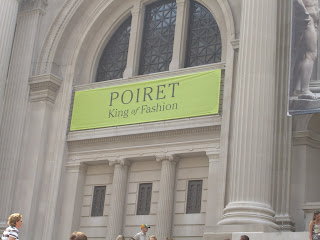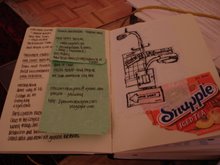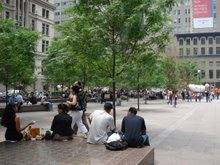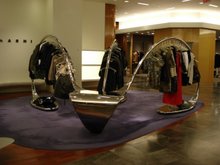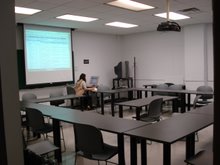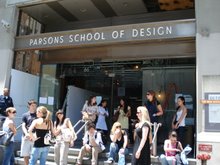
Sunday, July 22, 2007
Saturday, July 14, 2007
New York Experience

I visited New York City several time for business but did not remember much about Big Apple. I was juggling with serious business stuff and my family and did not have much chance to explore. But for the first time, I came here alone without portfolio and my heavy diaper bag.
I planed this summer in New York City for 6 years. (I know it sound strange but true) I have been struggling with motherhood and believe or not, my best textbook was “ What to expect when you’re expecting”. When I checked into the dorm room and met students from all around world, I started to shrink. How can I survive from all young, talented people? I was thinking that I came to Parson to get a confidence, not losing them.
Then first day of school, as soon as I entered the class, I was realized that I chose wrong class!!! It did not sound like colorful and fancy design course. When Laura explained about “Ethnography research” I had to open my dictionary. Eth…what? (I am sorry but I am not familiar with all these term even though my husband teaches Sociology. Who discuss with their husband about ethnography research anyway?)
Now, it’s been 2-week in New York City and my small black notebook is filled with research notes and ideas for my next art class, also for my portfolio.
As an art student who is slightly older than other student and who has a lack of imagination, this New York experience is really inspiring me . The places we went to and getting ideas from classmates is a great learning as well.
For the rest of the class, I want to keep learning and exploring as much I can. And try to be like my sons who have a lot of imagination and unlimited questions.
I hope you all have wonderful weekend and see you in class on Monday! - Sunyoung
Friday, July 13, 2007
Food Deployment Systems: From the streets to the MoMA
While visiting the MoMA, I decided to investigate how a modern art museum would approach the design of it’s restaurant. I didn’t stay to eat, but I found their ordering system quite interesting. Essentially you place your order, take a number, and place the number on your table. This negates the need for reservations and it allows servers to easily determine where the food is supposed to go.

What I find interesting is that a similar system was being used by entrepreneurial street vendors. For those of you who are unaware, every Monday night of the summer HBO puts on a movie that people are free to come and watch. Although the movie can’t begin until darkness, people fill up the park as early as 5pm. Here is a video that shows the scope of the events:

Street vendors will take peoples orders and then give them a balloon with a number on it. This makes their customers easy to spot from a distance and also allows them to sell more food. From the street to the MoMA, it’s interesting to see how effective system designs are put into action.
Keep it in the short grass,
-Brendon

What I find interesting is that a similar system was being used by entrepreneurial street vendors. For those of you who are unaware, every Monday night of the summer HBO puts on a movie that people are free to come and watch. Although the movie can’t begin until darkness, people fill up the park as early as 5pm. Here is a video that shows the scope of the events:

Street vendors will take peoples orders and then give them a balloon with a number on it. This makes their customers easy to spot from a distance and also allows them to sell more food. From the street to the MoMA, it’s interesting to see how effective system designs are put into action.
Keep it in the short grass,
-Brendon
friday morning
What a week! Time is flying by, and the more I see, the more I feel like I haven't seen. I think the time will come to leave, and I'll still have a list of places I want to explore!
Yesterday we went to the Museum of New York City, which was fascinating. Photos of the building of major bridges that now connect the burroughs and Manhattan were works of art, in their own right, although their original purpose had been strictly documentary. A well produced short film explained the founding of the city, from the roots of the Dutch and their New Amsterdam. It was interesting to see how progress shaped the city, more than city planners sitting in their meeting halls.
There was much more to see in the museum: an exhibit on a Broadway costumer, a history on Jews in NYC, an old toy display with a dollhouse containing miniature works of art by modern artists of the early twentieth century. The Rockefeller rooms were on the top floor of the museum, and there was an interesting exhibit on the interior of New York City, which fascinated the historian and interior designer in me.
Now we're off to a Friday of more adventure and learning!
-Whitney
Yesterday we went to the Museum of New York City, which was fascinating. Photos of the building of major bridges that now connect the burroughs and Manhattan were works of art, in their own right, although their original purpose had been strictly documentary. A well produced short film explained the founding of the city, from the roots of the Dutch and their New Amsterdam. It was interesting to see how progress shaped the city, more than city planners sitting in their meeting halls.
There was much more to see in the museum: an exhibit on a Broadway costumer, a history on Jews in NYC, an old toy display with a dollhouse containing miniature works of art by modern artists of the early twentieth century. The Rockefeller rooms were on the top floor of the museum, and there was an interesting exhibit on the interior of New York City, which fascinated the historian and interior designer in me.
Now we're off to a Friday of more adventure and learning!
-Whitney
Thursday, July 12, 2007
NYC bicycle commuting
Research.
I just found this on youtube. From Midtown to Chelsea on a fixed gear bicycle! This is definitely not how we do it in Denmark..
//ANDERS//
Extra BIG

Concerning the project "Superhabour" I talked about wednesday.
It turns out that there are several reasons why the project is on hold. First and foremost is the fact that the connection between Denmark and Germany "The Fermen Bridge" is not being build in the near future after all. The project "Red Star Habour" though gives the impression that a similar project in Guangxi Province, China, is in the talks. Take a look yourself - www.big.dk
Here is a bio I found on Bjarke Ingels (the architect):
Having co-founded PLOT Architects in 2001, Bjarke Ingels started his own office in 2006: BIG / Bjarke Ingels Group. Through a series of award-winning design projects, Ingels has created an international reputation as a member of a new generation of architects that combine shrewd analysis, playful experimentation, social responsibility and humour. In 2004 he was awarded the Golden Lion at the Venice Biennale for the Stavanger Concert House and the following year received the Forum Award for the VM houses. Recently he has been nominated for the Mies van der Rohe Award as well as the International Iakov Chernikhov Prize. The work of BIG challenges the role of the architect. Through a series of projects BIG has pro-actively proposed projects that have often triggered public debate and influenced urban politics. The High Square project is a proposal for a public square in Copenhagen on top of an existing department store. In the Mountain Dwellings which are under construction, a parking block is transformed into a hillside covered by housing units. By practicing what Ingels describes as 'programmatic alchemy', BIG often mixes conventional ingredients such as living, leisure, working, parking and shopping into new forms of symbiotic architecture. These projects clearly represent BIG's efforts to free architectural imagination from habitual thinking and standard typologies in order to deal with the constantly evolving challenges of contemporary life. Bjarke Ingels has also been visiting professor at Rice University's School of Architecture and in spring 2007 Bjarke Ingels will be a visiting professor at Harvard University's Graduate School of Design.
//ANDERS//
Day at the Museums

 In the Digitally Mastered: Recent Acquisitions from the Museum's Collection at the MOMA, I notice a Magazine display stating that both the Designer and the Audience (the user) are partners in creating a product. The design should be clear, feel personable and lead us through an ever changing and growing world.
In the Digitally Mastered: Recent Acquisitions from the Museum's Collection at the MOMA, I notice a Magazine display stating that both the Designer and the Audience (the user) are partners in creating a product. The design should be clear, feel personable and lead us through an ever changing and growing world.I am not sure if many of you had a chance to read or view the exhibit Project 85: Dan Perjovschi (What Happened To Us?). He played on words and drew stick figure images mocking current events. This wall of art also had a light but in your face tone. It immediately captured my attention since the images were juxtaposed and I did not know where to begin to start.
The Public and the Private
On my way to the Wall Street/ Nassaust Street crossing at 2.00 pm 6th July 2007.
I have learnt to believe that there is a fine line that divides the private from the public. And in the same breath question myself on the obvious overlap.While walking through the Financial district I came across a small seating area where there were a large number of people either sipping coffee, waiting for others or simply using their cell phones. Most of them were in business suits probably on their lunch break. Did i mention most of them were using their cell phones...im guessing most of them were having private conversations in a public space...so what becomes private and what remains public.
How would we explain the smoking signs that we see practically everyday, forbidding us to smoke in 'public' area. Being inside a building is private but a step outside of it would be public.
What surprised me when I got to the crosing of Wall Street is the physical divide between the Stock Exchange building and the remaining road. The road stiwched roles and became a 'casual' space for tourists. There were tables, chairs, there were children, flashes from cameras, dogs but hardly any people in business suits in that half of the road.
I dont know who defines the public from the private or visa versa...still trying to find out... Shahana Mehta
I have learnt to believe that there is a fine line that divides the private from the public. And in the same breath question myself on the obvious overlap.While walking through the Financial district I came across a small seating area where there were a large number of people either sipping coffee, waiting for others or simply using their cell phones. Most of them were in business suits probably on their lunch break. Did i mention most of them were using their cell phones...im guessing most of them were having private conversations in a public space...so what becomes private and what remains public.
How would we explain the smoking signs that we see practically everyday, forbidding us to smoke in 'public' area. Being inside a building is private but a step outside of it would be public.
What surprised me when I got to the crosing of Wall Street is the physical divide between the Stock Exchange building and the remaining road. The road stiwched roles and became a 'casual' space for tourists. There were tables, chairs, there were children, flashes from cameras, dogs but hardly any people in business suits in that half of the road.
I dont know who defines the public from the private or visa versa...still trying to find out... Shahana Mehta
Wednesday, July 11, 2007

I didn't mention this yesterday when we were at the MET but there was a painting that stood out to me. Charles Demoth did a painting called Figure 5 in Gold which was an homage to the poet, William Carlos Williams. William's initials and names are seen throughout the painting as well as Charles'.
Trying to focus and relate it to the branding issue, I found that the painting itself could be used almost as a branding concept for Willaim Carlos Williams's works. The whole idea of paying homage to a friend as well as representing William's poem, The Great Figure, is a way of using design as a means of displaying respect, therefore creating an image that coincides with Williams' poems.
Tuesday, July 10, 2007
Walmart Failed in Germany
Wal-Mart gives up Germany
By Mark Landler The New York Times
SATURDAY, JULY 29, 2006
FRANKFURT Wal-Mart Stores, admitting defeat in Germany's giant but cutthroat retail market, announced Friday that it would sell its 85 stores here to a German retailer, incurring a loss of $1 billion.
The decision to sell out to the Metro Group came two months after Wal- Mart sold its stores in South Korea and amounts to a rare retreat by the world's largest retailer from its breakneck global expansion.
In Germany, analysts say, Wal-Mart never got traction in a market characterized by unrelenting price competition, well-established discounters and the cultural resistance of German shoppers to hypermarkets, which sell fresh vegetables a few aisles away from lawn mowers.
"They walked into a triple-witching hour in Germany," said James Bacos, the director of the retail and consumer goods practice at Mercer Management Consulting in Munich. "They got into Germany at a time when the whole market was shifting away from their model."
Wal-Mart does not break down its results by country, but analysts estimate that it has lost money for most of the eight and a half years it has operated here, sometimes hundreds of millions of dollars a year.
Wal-Mart and Metro did not disclose the terms of the sale, but Wal-Mart said it would record a pretax charge of about $1 billion in the second quarter of fiscal 2007 to write off its German investment.
"We put a good effort into the country," a spokeswoman, Beth Keck, said. "But as we looked at our competitive environment here, we realized it was going to be hard to achieve the results we expect."
Wal-Mart, based in Bentonville, Arkansas, made a similar calculation in South Korea, selling 16 stores to a local retailer, Shinsegae, for $882 million. As in Germany, Wal-Mart did not appeal sufficiently to local tastes, and it struggled to compete with aggressive Korean discounters.
Despite these setbacks, Keck said, Wal-Mart continues to thrive in many countries outside the United States, with particularly robust markets in Mexico, Canada, Brazil and Britain. Wal-Mart had international net sales of $7.6 billion in June, a 29.5 percent increase over June 2005, though nearly two-thirds of that gain came from acquisitions.
Metro, one of the largest German retail conglomerates, said it planned to fold the 85 stores into its chain, Real, which is bigger than Wal-Mart but also ailing. Wal-Mart's German stores employ 11,000 people and generate €2 billion, or $2.5 billion, a year in sales, according to Metro.
By adding those stores to Real's 550 supermarkets and hypermarkets, Metro said it could fortify its purchasing power in what is the world's third- largest retail market. The company said it was committed to hypermarkets.
Some of Wal-Mart's troubles stem from the way it broke into the German market in 1998, according to analysts. By acquiring the outlets of two second- tier retailers, Wertkauf and Interspar, Wal-Mart wound up with a hodgepodge of stores, geographically dispersed and often in poor locations.
The company initially installed American managers, who made some well-intentioned cultural gaffes, like offering to bag groceries for customers (Germans prefer to bag their own groceries) or instructing clerks to smile at customers (Germans, used to brusque service, were put off).
Wal-Mart later went through German managers, before appointing David Wild, a former executive at Tesco, the British chain. He tried to win over customers by selling organic meat and produce.
"They found they had some things to learn about the German market, and they did change, but maybe too late," Bacos said.
Other problems, however, were largely outside Wal-Mart's control. Two German discounters, Aldi and Lidl, dominate the grocery business, with smaller shops that feature cut- rate, though still good-quality, food. Aldi also heavily promotes one-week sales, featuring deeply discounted merchandise, ranging from wine to garden hoses, which draw customers back.
While Wal-Mart's vast size gives it enormous leverage in purchasing clothing and other goods, it must buy much of the food for its German stores locally. And there, it lacks the muscle of Aldi, which has 4,100 shops and a presence in nearly every town in the country.
"Germany is the home of the discounter," said Mark Josefson, a retail analyst at Kepler Securities in Frankfurt. "Wal-Mart is not competing on price, and that is one of its main attributes in its home market."
Beyond these competitive pressures, there is the reality of the German consumer - one of the most parsimonious and price-conscious in Europe. While consumer confidence has picked up recently, Bacos said the proportion of household income that Germans spend on retail purchases continues to decline. Profit margins in German retailing are the lowest in Europe.
"Wal-Mart has tried, for the better part of a decade, to adapt to this market," he said. "I think they've looked at the situation and come to the conclusion, 'How long is it going to take?'"
-Sunyoung-
By Mark Landler The New York Times
SATURDAY, JULY 29, 2006
FRANKFURT Wal-Mart Stores, admitting defeat in Germany's giant but cutthroat retail market, announced Friday that it would sell its 85 stores here to a German retailer, incurring a loss of $1 billion.
The decision to sell out to the Metro Group came two months after Wal- Mart sold its stores in South Korea and amounts to a rare retreat by the world's largest retailer from its breakneck global expansion.
In Germany, analysts say, Wal-Mart never got traction in a market characterized by unrelenting price competition, well-established discounters and the cultural resistance of German shoppers to hypermarkets, which sell fresh vegetables a few aisles away from lawn mowers.
"They walked into a triple-witching hour in Germany," said James Bacos, the director of the retail and consumer goods practice at Mercer Management Consulting in Munich. "They got into Germany at a time when the whole market was shifting away from their model."
Wal-Mart does not break down its results by country, but analysts estimate that it has lost money for most of the eight and a half years it has operated here, sometimes hundreds of millions of dollars a year.
Wal-Mart and Metro did not disclose the terms of the sale, but Wal-Mart said it would record a pretax charge of about $1 billion in the second quarter of fiscal 2007 to write off its German investment.
"We put a good effort into the country," a spokeswoman, Beth Keck, said. "But as we looked at our competitive environment here, we realized it was going to be hard to achieve the results we expect."
Wal-Mart, based in Bentonville, Arkansas, made a similar calculation in South Korea, selling 16 stores to a local retailer, Shinsegae, for $882 million. As in Germany, Wal-Mart did not appeal sufficiently to local tastes, and it struggled to compete with aggressive Korean discounters.
Despite these setbacks, Keck said, Wal-Mart continues to thrive in many countries outside the United States, with particularly robust markets in Mexico, Canada, Brazil and Britain. Wal-Mart had international net sales of $7.6 billion in June, a 29.5 percent increase over June 2005, though nearly two-thirds of that gain came from acquisitions.
Metro, one of the largest German retail conglomerates, said it planned to fold the 85 stores into its chain, Real, which is bigger than Wal-Mart but also ailing. Wal-Mart's German stores employ 11,000 people and generate €2 billion, or $2.5 billion, a year in sales, according to Metro.
By adding those stores to Real's 550 supermarkets and hypermarkets, Metro said it could fortify its purchasing power in what is the world's third- largest retail market. The company said it was committed to hypermarkets.
Some of Wal-Mart's troubles stem from the way it broke into the German market in 1998, according to analysts. By acquiring the outlets of two second- tier retailers, Wertkauf and Interspar, Wal-Mart wound up with a hodgepodge of stores, geographically dispersed and often in poor locations.
The company initially installed American managers, who made some well-intentioned cultural gaffes, like offering to bag groceries for customers (Germans prefer to bag their own groceries) or instructing clerks to smile at customers (Germans, used to brusque service, were put off).
Wal-Mart later went through German managers, before appointing David Wild, a former executive at Tesco, the British chain. He tried to win over customers by selling organic meat and produce.
"They found they had some things to learn about the German market, and they did change, but maybe too late," Bacos said.
Other problems, however, were largely outside Wal-Mart's control. Two German discounters, Aldi and Lidl, dominate the grocery business, with smaller shops that feature cut- rate, though still good-quality, food. Aldi also heavily promotes one-week sales, featuring deeply discounted merchandise, ranging from wine to garden hoses, which draw customers back.
While Wal-Mart's vast size gives it enormous leverage in purchasing clothing and other goods, it must buy much of the food for its German stores locally. And there, it lacks the muscle of Aldi, which has 4,100 shops and a presence in nearly every town in the country.
"Germany is the home of the discounter," said Mark Josefson, a retail analyst at Kepler Securities in Frankfurt. "Wal-Mart is not competing on price, and that is one of its main attributes in its home market."
Beyond these competitive pressures, there is the reality of the German consumer - one of the most parsimonious and price-conscious in Europe. While consumer confidence has picked up recently, Bacos said the proportion of household income that Germans spend on retail purchases continues to decline. Profit margins in German retailing are the lowest in Europe.
"Wal-Mart has tried, for the better part of a decade, to adapt to this market," he said. "I think they've looked at the situation and come to the conclusion, 'How long is it going to take?'"
-Sunyoung-
Sunday, July 8, 2007
Week 1 at The New School, Parsons
Orientation lasted an hour after which we had an hours lunch break, I decided to eat salad. Lost track of time...rushed to class. Luckily for me I reached on time. Didnt want to be late on my very first day. There are about 17 people in class...people from all over the country. We managed a round of introduction. Laura described the course to us, gave us our syllabus and then in the afternoon we decided to get out of class and go to the Cooper Hewitt,National Design Museum. We were asked to choose one piece that was most inspirational. I decided on 'Speak up'-the concept of a blog...that would probably explain why I initiated a class blog.
'The Design of Everyday Things' by Donald A. Norman is what we are reading in class. It essentially talks about the psychology of everyday things and how people interact with them.
Whats interesting about class is that through the observation studies assignments we get to see a lot of New York. Infact its amazing how much of the city we have covered and there is still so much to see. ( South Street, Wall Street, 57th Street 5 th Avenue, Columbai University, China Town ) Thats quite a lot for a week.
Saks 5th Avenue is a store that was a part of my observation paper.
"The demand for retail spaces is growing and it is only now that the designer is getting familiar with consumer emotions, lifestyle and behavior. Retail stores have gradually begun to spring up in all parts of the city and this makes it difficult for designers to conceptualize a store which is better than the previous store they designed. The challenge for the designer now is how they could design a retail space that would conjure up inviting environments where shoppers enjoy the experience of shopping.
The form and function of the store/mall has extended to a space where everything falls under one roof, where the consumer need not go to any other store barring the one he/she is in.
The scale and variety within a particular store is what surprises the consumer time after time. Consumer behaviour attempts to understand the buyer decision making process, both individually and in groups. It also tries to assess influences on the consumer from groups such as family, friends, reference groups, and society in general.
Stores need to be easily accessible and not someplace where the consumer needs to travel miles to get to the shopping area. The concept of a shop-in-shop brings the consumer to a space where all brands are under one roof, thus making it convenient for the consumer to shop and at the same time giving him/her enough to choose from. "- Shahana Mehta
Will try and posting my paper online.
Well its been a good week and I enjoy my class...more later
Orientation lasted an hour after which we had an hours lunch break, I decided to eat salad. Lost track of time...rushed to class. Luckily for me I reached on time. Didnt want to be late on my very first day. There are about 17 people in class...people from all over the country. We managed a round of introduction. Laura described the course to us, gave us our syllabus and then in the afternoon we decided to get out of class and go to the Cooper Hewitt,National Design Museum. We were asked to choose one piece that was most inspirational. I decided on 'Speak up'-the concept of a blog...that would probably explain why I initiated a class blog.
'The Design of Everyday Things' by Donald A. Norman is what we are reading in class. It essentially talks about the psychology of everyday things and how people interact with them.
Whats interesting about class is that through the observation studies assignments we get to see a lot of New York. Infact its amazing how much of the city we have covered and there is still so much to see. ( South Street, Wall Street, 57th Street 5 th Avenue, Columbai University, China Town ) Thats quite a lot for a week.
Saks 5th Avenue is a store that was a part of my observation paper.
"The demand for retail spaces is growing and it is only now that the designer is getting familiar with consumer emotions, lifestyle and behavior. Retail stores have gradually begun to spring up in all parts of the city and this makes it difficult for designers to conceptualize a store which is better than the previous store they designed. The challenge for the designer now is how they could design a retail space that would conjure up inviting environments where shoppers enjoy the experience of shopping.
The form and function of the store/mall has extended to a space where everything falls under one roof, where the consumer need not go to any other store barring the one he/she is in.
The scale and variety within a particular store is what surprises the consumer time after time. Consumer behaviour attempts to understand the buyer decision making process, both individually and in groups. It also tries to assess influences on the consumer from groups such as family, friends, reference groups, and society in general.
Stores need to be easily accessible and not someplace where the consumer needs to travel miles to get to the shopping area. The concept of a shop-in-shop brings the consumer to a space where all brands are under one roof, thus making it convenient for the consumer to shop and at the same time giving him/her enough to choose from. "- Shahana Mehta
Will try and posting my paper online.
Well its been a good week and I enjoy my class...more later
Wednesday, July 4, 2007
Subscribe to:
Posts (Atom)








